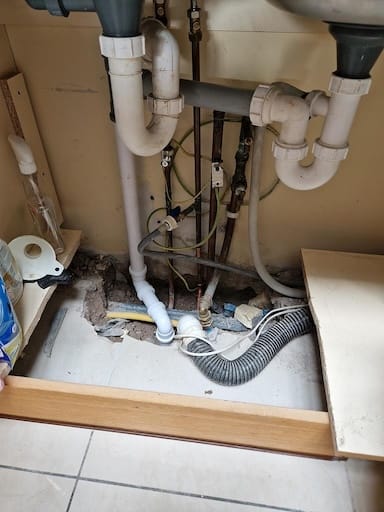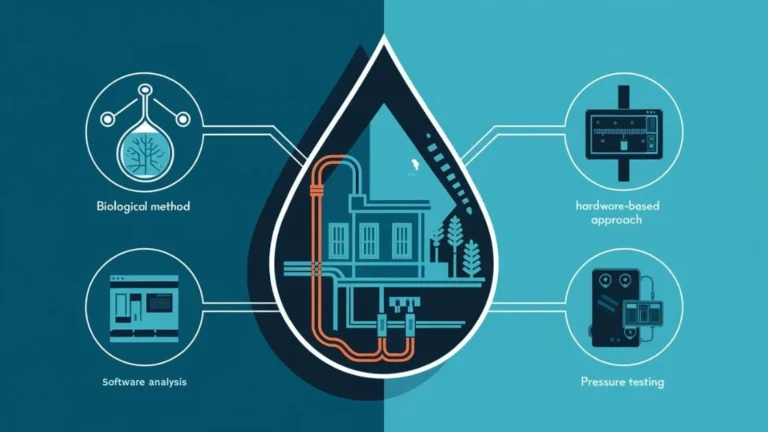Leaks, if left unchecked, can lead to catastrophic damage to buildings. But did you know that the methods of leak detection vary in complexity and effectiveness?
In this article, we’ll discuss four effective techniques for leak detection: the traditional plumber approach, acoustic testing, thermal imaging, and the tracer gas method.
Leak detection can often be a complex task, especially in homes with concrete floor slabs. These slabs are commonly used in the UK due to their durability and strength; however, they can conceal leaks, leading to significant damage if not addressed promptly.
We will focus on locating leaks in concrete floor slabs of domestic properties, discussing the necessary equipment, optimal use cases, advantages, and disadvantages of each method.
By then end of the article, you’ll have the knowledge to choose the right leak detection technique for your specific situation.
What Is The Traditional Plumber Approach
The traditional plumber approach involves a systematic inspection of the plumbing system by a trained plumber. This technique usually includes visual inspections, pressure testing, and sometimes, a bit of guesswork based on experience. Plumbers often check visible pipes, joints, and fittings for signs of wear, corrosion, or leaks.

Equipment Needed
- Wrenches and pliers: For checking connections and tightening loose fittings.
- Pressure gauges: To monitor changes in water pressure that may indicate a leak.
- Cameras: Simple visual inspections may be complemented by cameras for hard-to-reach areas.
Best Use Cases
This approach is best used in straightforward scenarios where leaks are visible or suspected in accessible areas, such as under sinks or in basements. It can also be beneficial for initial assessments before using more advanced techniques.
Advantages
- Cost-effective: Generally less expensive as it primarily requires manual tools.
- Immediate results: A plumber can often identify leaks quickly with minimal equipment.
- Familiarity: Most homeowners are comfortable calling a plumber for assistance.
Disadvantages
- Limited scope: May not effectively identify hidden leaks within concrete slabs.
- Dependence on experience: The accuracy largely depends on the plumber’s skill and knowledge.
- Time-consuming: Can take longer to locate leaks without advanced equipment.
What Is Acoustic Testing?
Acoustic leak testing involves listening for sounds of leaking water using sensitive microphones and sound detection equipment. This method is particularly effective for locating leaks in concealed areas such as concrete slabs.
Equipment Needed
- Acoustic leak detectors: Specialised devices that can amplify the sound of water escaping from pipes.
- Headphones: For the technician to listen closely to the detected sounds.
- Recording equipment: To document findings for further analysis.
Best Use Cases
Acoustic testing is ideal for identifying leaks in locations that are difficult to access or hidden, particularly within concrete slabs or walls. It is most effective when there is a significant pressure difference between the leaking pipe and the surrounding environment.
Advantages
- Precision: Capable of accurately locating leaks in hard-to-reach areas.
- Non-invasive: Does not require cutting into walls or floors, reducing damage to property.
- Real-time results: Immediate identification of leak locations.
Disadvantages
- Skill-dependent: Requires trained professionals to interpret the sounds accurately.
- Background noise interference: Can be affected by ambient noise, making it less effective in certain environments.
- Cost: More expensive than traditional methods due to specialised equipment.
What Is Thermal Imaging?
Thermal imaging uses infrared cameras to detect variations in temperature caused by leaking water. This technique is particularly useful for identifying leaks in concealed locations, including under concrete floor slabs.
Equipment Needed
- Thermal imaging camera: High-quality cameras that detect temperature differences.
- Laptops or tablets: For real-time data analysis and documentation.
- Software: To analyse thermal images and provide reports on findings.
Best Use Cases
Thermal imaging is most effective in detecting leaks in hidden areas, such as behind walls or under floors. It is particularly useful for detecting hot or cold water leaks, as they often create temperature differences that can be easily identified.
Advantages
- Highly accurate: Provides precise data on the location of leaks.
- Non-destructive: No need for invasive procedures, preserving the integrity of the property.
- Visual representation: Offers clear visual data that can be shared with homeowners for better understanding.
Disadvantages
- High initial cost: The equipment can be expensive to purchase or rent.
- Requires training: Proper interpretation of thermal images requires skilled technicians.
- Limited effectiveness in certain conditions: Weather and environmental conditions can affect results.
What Is The Tracer Gas Method?
The tracer gas method involves introducing a harmless gas, usually hydrogen or helium, into the plumbing system. When there is a leak, the gas escapes and can be detected above ground using a gas detector.
Equipment Needed
- Tracer gas cylinder: Contains the gas to be introduced into the plumbing system.
- Gas detectors: Sensitive devices that can detect the presence of tracer gases.
- Piping and fittings: For connecting the gas cylinder to the plumbing system.
Best Use Cases
This method is ideal for locating leaks that are difficult to find using other techniques, particularly in large or complex plumbing systems. It is especially useful for detecting leaks in concrete slabs where traditional methods may fail.
Advantages
- Highly effective: Very reliable for locating leaks that are otherwise undetectable.
- Versatile: Can be used in various plumbing systems, including those with complex layouts.
- Rapid results: Can quickly pinpoint the location of a leak.
Disadvantages
- Requires expertise: Proper implementation and detection require trained professionals.
- Safety precautions: Although safe, the use of gases necessitates certain precautions to ensure safety.
- Cost: The equipment and expertise needed can be more expensive than other methods.
Conclusion
Leak detection in residential dwellings, particularly in concrete floor slabs, is essential for preventing significant damage and maintaining property integrity. Each of the techniques discussed—traditional plumbing methods, acoustic testing, thermal imaging, and the tracer gas method—offers unique advantages and disadvantages. The best approach often depends on the specific circumstances of the leak and the accessibility of the plumbing system. Find out more about Non-Invasive Leak Detection Methods.
While traditional methods are cost-effective and familiar to many homeowners, advanced techniques like acoustic testing and thermal imaging provide precision and non-invasive options for locating leaks. The tracer gas method stands out for its reliability in complex plumbing systems but comes with its own set of requirements and costs.
By understanding these techniques, homeowners can make informed decisions on leak detection methods that suit their needs and ensure their homes remain safe and sound. Whether you are a homeowner facing the challenges of leak detection or a professional in the plumbing industry, understanding these techniques will enhance your ability to address leaks effectively.
Are you unsure about which type of leak detection is right for you?
Hidden leaks can lead to costly damages and repair bills. Act now to protect your home! Contact Northern Ireland’s trusted leak detection specialists today for a free consultation and peace of mind.



